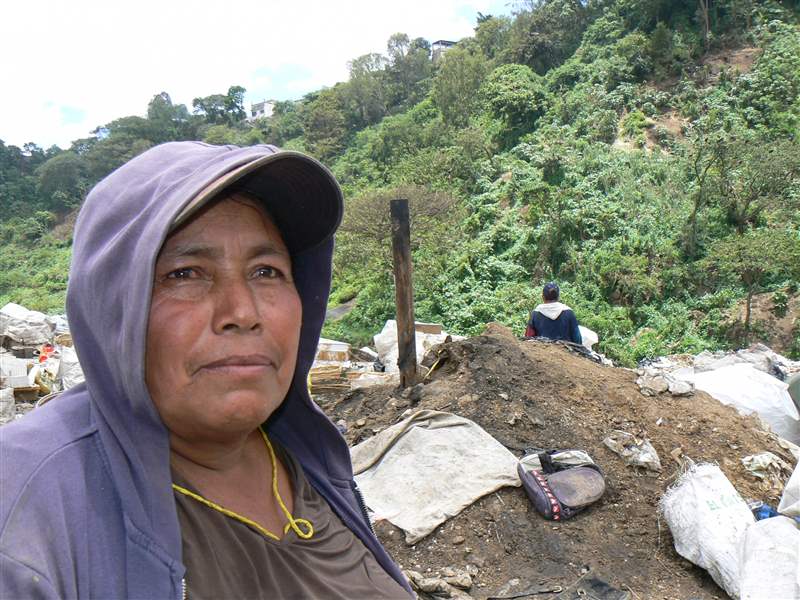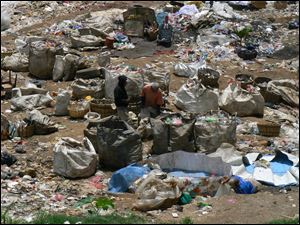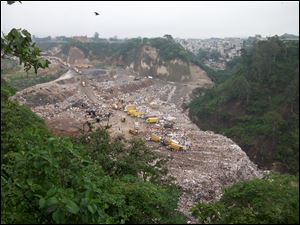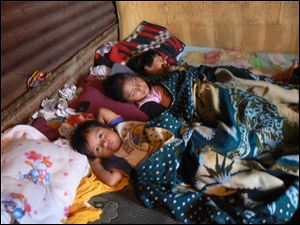
SCAVENGING FOR HOPE
Guatemalan laborers get help from Toledo
Each year, toledo group offers assistance
7/3/2011
Brenda Judith Lopez works 11 hours a day, six days a week at the dump for as much as $90 or as little as $18. She says her job’s been a blessing; she’s been able to raise her six children.
THE BLADE/DAVID YONKE
Buy This Image

Dump workers, or reciclidores, sort through the trash they gathered from trucks.
First of two parts
GUATEMALA CITY -- Under a steel gray sky dotted with hundreds of circling vultures, the rancid smell of decay in the air, more than a thousand reciclidores, or recyclers, trudge through the mud to position themselves for the next wave of garbage trucks.
Before the yellow-and-green vehicles can even grind to a halt, the recyclers are jumping aboard, grabbing trash bags, and leaping off with their bounty. Tearing the bags apart, they quickly sort through their fetid contents in search of plastic or glass bottles, scraps of cardboard, pieces of metal, and anything else they can sell for a few centavos.
It's a typical workday at Relleno Sanitorio -- the sprawling municipal dump in the heart of this teeming capital city.
"My mother brought me here when I was 2 months old and I've been here ever since," Brenda Judith Lopez said.
Mrs. Lopez, 47, works 11 hours a day, six days a week, and brings home as much as $90. That's in a good week, she said. In a bad week, her 66 hours of scavenging can bring as little as $18.
The dump jobs have no health care or other benefits, and the government provides no unemployment, welfare, or Social Security benefits.
Providing assistance to those impoverished Guatemalans is why students from Toledo's St. John's Jesuit High School head south each year.
PHOTO GALLERIES:
Life in Guatemala City Ghettos
St. John's Visit to Guatemala Schools
RELATED ARTICLES:
St. John's students serve as role models
Strides made in improving worker' health, safety
Those trips are organized by International Samaritan, a nonprofit organization founded at St. John's in 1995 as Central American Ministries by the Rev. Don Vettese, who was the school's president at the time.
In this impoverished Central American nation, where more than half the population lives below the national poverty line and 18 percent live in extreme poverty, Mrs. Lopez is grateful to have a job.

The dump in Zone 3 covers 750 acres. The many dangers include avalanches, when mountains of trash shift, slide, and topple over.
"This dump has been a big blessing for everyone working here," she said. "I've been able to raise six children through this work."
Her friend Elida Centano, 29, a small woman nicknamed "Half a Meter," collects plastic soft-drink bottles and plastic wrap.
"I have been working here 15 years," she said. She starts when the dump's gates open at 7 a.m. and works until they close at 6 p.m.
"I don't like it, but at least it's work," she said. "I hope someday to get a job cleaning offices."
Mrs. Lopez is not expecting to find another line of work. She predicts that she will be at the dump "until God calls me home."
Dangerous work
For some dump workers, God calls them early.
Mrs. Lopez and Ms. Centano both have lost friends and relatives in garbage-dump avalanches, when storm winds and rains cause the mountains of trash to shift, slide, and topple over, burying the workers.
One of the worst disasters in the dump's 66-year history occurred in 1998, when Hurricane Mitch pummeled Central America. At least 20 people died in Guatemala's city dump, officials said. Untold reciclos have lost their lives over the years in smaller avalanches, accidents, fires, or explosions.
"It's very dangerous work," Mrs. Lopez said.
Rosa Yup, 42, who scavenges for plastic bottles, also works in fear. She has nine children, five still at home.
"When it rains, I am sad," she said. "The plastic goes down even deeper and I can't reach it. I fear that an avalanche can come. I don't want to die because I have small children to take care of."
GUATEMALA AT A GLANCE
Population: 13.8 million
Age breakdown: 0-14,38.1 percent; 15-64, 58 percent; 65 and older, 3.9 percent
Capital: Guatemala City, population 1.5 million
Infant mortality rate: 26.02 deaths per 1,000 live births
Life expectancy: 70.9 years
Major infectious diseases: bacterial diarrhea, hepatitis A, typhoid fever, dengue fever, malaria.
SOURCE: CIA Factbook
'A microbusiness'
Ms. Yup said she works about eight hours and gathers about 100 pounds of bottles. She sells them to a middleman for about $5.
The middlemen drive down into the dump in pickup trucks and leave with massive bags of scrap materials, which they sell to larger recycling businesses.
"This is a microbusiness," said Daniel Ponce, director of the landfill. "They work by themselves and they can sell it to anyone that [they] want to sell it to."
Julio Choquin Munoz, 44, has spent his whole life laboring in and around the city dump. He has worked his way up from scavenging to being a middleman.
Mr. Munoz has six people working for him, "but my wife is the boss," he said with a smile.
Mr. Munoz stacks his recyclables in huge plastic bags that cover long stretches of sidewalks and bulge into the streets of a neighborhood near the dump.
He said he buys between $120 and $140 worth of clear and white plastic bottles every week and sells them to factories that make twice-weekly pickups.
How much profit does he make?
"Un poco, un poco," he replies, puffing a cigarette. A little.
Nearby, three teenagers hold glass bottles by the neck and use them like hammers to smash other bottles that are stacked inside thick plastic bags. Their job is to condense the massive glass piles.
Eddie Perez, 16, said he works from 7 a.m. to 2 p.m. smashing bottles, then heads to the dump where he works from 2:30 to 7 or 8 p.m. He does this six days a week and earns about $70.

Helping hands
Back at the dump, Mrs. Yup, standing amid mud, roving dogs, and mounds of trash, said she has one day off a week.
"On Sunday, I clean my house," she said with a smile.
Unlike many dump workers who live in primitive shacks, Mrs. Yup and Mrs. Lopez have real homes.
"When some foreigners talked with me and explained they were going to build a house for me, I couldn't believe it," Mrs. Lopez said. "I almost fainted."
The home was built by International Samaritan. The nonprofit organization donated the homes to these two women's families and to about 475 others, part of a comprehensive effort to transform the lives of some of the world's poorest people.
Father Vettese said the home recipients must meet certain requirements.

Brenda Judith Lopez works 11 hours a day, six days a week at the dump for as much as $90 or as little as $18. She says her job’s been a blessing; she’s been able to raise her six children.
Their children have to attend one of the schools run by International Samaritan, and the parents must be drug-free and in a stable relationship. After several levels of screening, International Samaritan then questions other dump workers and neighbors about the applicants.
"The community has to approve them -- and the community certainly knows them better than we ever can," Father Vettese said.
The city of Guatemala donates the land and provides an infrastructure with water, sewer, and electricity. International Samaritan builds the simple cement-block houses for between $4,800 and $7,000 each.
Thirteen-year-old Erica Maritza Chaj lives with her mother and six older siblings in a salmon-colored home built by International Samaritan in La Libertad neighborhood, just around the corner from the organization's Centro Educativo Francisco Coll grade school.
A sixth-grade student, Erica said with a polite smile that she wants to be a math teacher.
On a recent rainy afternoon, she was cooking a meal of ground meat, onions, and peppers on a portable gas stove.
Her family has lived in the concrete-block home for five years, she said. The brothers have added a second level, with a wooden floor and metal walls and roof.
"We used to live in a house with tin plates. We used to have lots of flooding when it rained," Erica said. "Now we are very comfortable."
The homes built by International Samaritan are connected like tiny condos and painted pastel colors. Each house has about 520 square feet of space, with a living room and kitchen area, a bathroom, a laundry area, and one or two bedrooms.
Besides providing running water and protection from the elements and rodents, the homes offer important intangibles, Father Vettese said.
"A house means stability, hope, self-respect, and security," he said. "They can lock the doors and feel safe."
Harsher conditions
Many dump workers lack even such basic security and comfort.
Romelia Suret, for example, lives with her husband and three children -- ages 2, 6, and 8 -- in a shack made with corrugated tin walls and roof. The house has a small dirt yard, enclosed by a new tin fence.
There is no running water, no bathroom, no sink. The living quarters are lit by a bare bulb hanging from the ceiling. The floor is covered with rugs, but recent rains have caused the mud to seep through the carpet.
The Suret family members use a public restroom and a shower two blocks away and buy clean water by the drum -- about $1 for 30 gallons -- for drinking, cooking, and hand-washing clothes on a flat stone.
They used to live in a regular house in a neighborhood, Mrs. Suret said, but could no longer afford the rent.
"There's no rent here," she said with a smile.

Romelia Suret worries, as most mothers do, about her children. Mrs. Suret's house of tin is in a ghetto with alleys through which runs an open sewer and where standing water means a breeding ground for malaria-carrying mosquitoes. Her three children lie listless in bed. Although government doctors say nothing is wrong with them, private physicians say Jennifer, center, has E. coli.
When they moved from a regular house into the ghetto three years ago, the Surets had only plastic tarps and wood to use to build their house. A local evangelical church, Cristo de Camino, donated materials and built their tin house, she said.
Mrs. Suret worries about her family's health in the ghetto, which residents call Sandra de Colon -- named for the wife of the president in hopes of getting government money.
An open sewer runs through the middle of the dirt alleys, and a pond next to the Surets' home is filled with rank water and trash -- a breeding ground for malaria-carrying mosquitos.
Mrs. Suret, 28, and her husband both work in the dump, but she had to stay home for a week recently when her 8-year-old daughter, Jennifer, a second-grader at Coll school, was ill. Her two other children lay in bed, listless, beside Jennifer in the middle of the afternoon.
"We went to the public clinic and they said nothing was wrong with Jennifer. They always say nothing is wrong," Mrs. Suret said. "So we went to a private doctor, and paid 100 quetzales [about $14] for the doctor visit."
Jennifer was diagnosed with E. coli infection. The doctor gave her free samples of medication after Mrs. Suret said she had no more money. The daughter was hoping to return to school any day, her mother said.
Mrs. Suret said she dreams of having "a proper house and for my children to get ahead. I want to take my children as far away from here as I can -- through education."
Contact David Yonke at: dyonke@theblade.com or 419-724-6154.